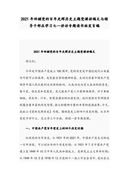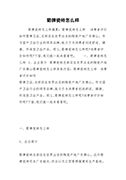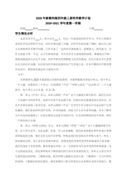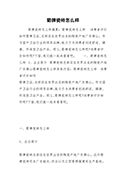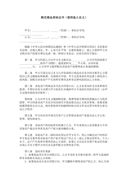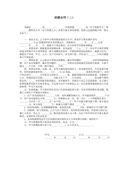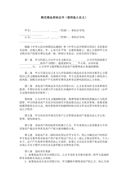2B Unit1 period 6(上海版牛津英语教案)(精选8篇)二年级英语教案
2B Unit1 period 6(上海版牛津英语教案)(精选8篇)
2B Unit1 period 6(上海版牛津英语教案) 篇1
lesson plan
school: shanghai shi yan primary school
name: ji junling
book: oxford english (shanghai edition)2b unit 1
topic: on the farm story(2) let’s enjoy
aims: !.structures: i’ve got… it goes…it has got…
2.function: using formulaic expressions to indicate what noises.
language focus: using formulaic expressions to indicate possessions.
aids: pictures, cassette player, computer.
procedurescontentsmethodspurposei.pre-task preparation:1.warmer(a song and the students’ presentations)(tape and a farm picture on the screen)sing a song:old macdonald has a farman english corner in the classroom: talk about the animals on the farm.(students may go around the class and talk with their friends.)eg:p1:hello, paul, look at this animal. it is a cow. it goes moo moo.通过歌曲活跃气氛,让学生走进农场,感受气氛,同时展示和巩固学生已学知识。2. questions & answers what do you hear on the farm? (tape)ask and answer: teacher plays the cassette about the sounds of the animals. students do pair work.pa:ask the partner to answer the question.pb: answer.3. spelling:hen, chick, duck, cow, sheep, pig(words)ps: spell the words.t-pa-pb-pc ii.while-task procedure:1.introduction:(computer)show the whole story .t: retell the story and ask the questions:e.g. what does the farmer say?present the sentence: it has got…整体感知故事内容,通过多媒体展示,直观、形象、生动。学生选择自己喜欢的动物编故事,提高兴趣,发展能力。2.imitation: ps: students try to read after the tape and retell the story. 3.substitution (show the different pictures of the animals on the screen)students choose and create a new story in groups.iii. post-task activity:1.a game: find out the more animal sounds on the farm:expand the student’s imagination and their abilities.e.g.: i’ve got a sheep. it goes ba ba. i’ve got a frog. it goes glug glug. 学生寻找其他动物的声音,发挥学生的想象能力,新旧知识和课内外知识有机结合,同时为学生提供自主发展的空间2.a competition: who is the best story-teller students tell the story to class, and judge.the title of the story: the sounds of the farm animals.v. assignment:tell a new story about the farm animals to parents . 巩固课堂学习内容,延伸课堂知识。
教案设计说明:
1.多媒体的运用在导入新授知识中起了很好的作用,它直观的展示了教学的重点部分,同时为学生开展之后的英语活动起起到铺垫的作用,如post-task activity中的编故事,学生因为有了先前的铺垫,在之后学习中显得容易和轻松。
2.注重前后知识的衔接。知识在于积累,在这个内容之前,牛津教材2b中曾经出现过一些农场的动物,在教学环节中设计了一个编故事的内容,促使学生进行思考,帮助学生回忆已学知识,同时呈现出他们已有的知识,使知识的雪球越滚越大,体现教材特色。
3. 在各种游戏活动中培养学生学习英语的兴趣,发展情感,在不知不觉中提高了学生的英语能力,比如说post-task activity中设计让学生说出更多的动物的声音,学生结合自己的生活经验,肯定有很多意想不到的答案,教师及时点评,学生的收获将会更多,同时,游戏也使学生有了合作和竞争的意识。
2B Unit1 period 6(上海版牛津英语教案) 篇2
lesson plan
school: penglai no.2 primary school
name: zhang yingying
book: oxford english (shanghai edition)2b unit 1
topic: farm animal
aims: 1. structures: draw the cow on the paper.
2.word: cow
3.function: using "draw … on the paper".
language focus: using imperatives to give simple instructions.
aids: pictures, realia
procedurescontentsmethodspurposei. pre-task preparation1. warming-upps: sing a song about animals.1. 通过歌曲,让学生对动物有初步的印象。2. 描述动物,为课文最后的综合练习打下基础。3.帮助学生辨别什么是野生动物,什么是农场里动物,丰富学生的知识,进一步激发他们学习的兴趣。 2. questions and answerswhich animal do you like best? why?which animal do you have as a pet?do you like …?t: ask pupils to answer the questions.pn: answer.pa: ask questions.pb: answer.3. quick responsetigers, sheep, elephants, crocodiles, ducks, cows(show the pictures)ps: farm animals.ps: wild animals. ii.while-task procedurecontent 1: cow1. introduction:t: elicit ‘cow’ from the previous game. what’s this? 2. imitation: cow1) t: ask pupils to follow.t-ps2) t: spell the word.pa-pb-pn通过机械性的仿说及拼读,使学生对所学单词基本掌握。3. activity: making sentences.t: say something about cows.ps: do pair work. 4. rhyme: a cow and an oxcow, cow, a lovely cow,eat grass, make nice milk.ox, ox, a strong ox,eat grass, work the land.(show the picture about ‘ox’)t: distinguish the two words. make a rhyme about ‘cow and ox’.ps-pn通过学生喜爱且容易上口的儿歌,帮助学生分辨cow与ox,了解它们之间的区别,而且也让英语教学进一步与自然学科联系起来。content 2:draw the cow on the paper.1. introduction:(show a cow on the paper)t: where’s the cow?pc: on the paper.t: ask pupils to draw a cow on the paper.ps: draw.t: what are you doing? where’s the cow?通过学生一边动手一边回答问题,将两句原本学过的句子由学生自己组成新句型,以培养他们自主学习的能力。2. imitation:draw the cow on the paper.t: ask pupils to follow.pn: show their pictures and say the sentences. 3. quick response: (show the picture)t: ask students to complete the sentence. draw the pencil …pg: complete the sentence with ‘on the paper’ in groups.t: show other pictures.pg: draw the ….pg: on the paper.用图片的形式,让学生进行新句型的操练,从机械操练上升到了有意义操练。4. game: guessing game(hand out some paper)pn: draw some pictures on the paper, and let other students guess. iii. post-task activity:1.talking about different cards. (give some paper to pupils)t: ask pupils to talk about what they can draw on the paper for different festivals.pg: work in groups.talking about birthday, new year, teacher’s day, etc. and introduce them.pa-pb-pn 为学生创设不同的情景,让他们通过所学的句型与实际生活相联系,以达到学用结合的目的。iv. assignmentdraw a picture on the paper and introduce the picture to your parents.
2B Unit1 period 6(上海版牛津英语教案) 篇3
lesson plan
school: shanghai shi yan primary school
teacher: li jun
book: oxford english (shanghai edition) 2b unit 1
topic: farm animals
aims: review the whole unit.
aids: letter cards, multi-media, word cards, wall-chart ...etc
procedurescontentsmethodspurposei. pre-task preparation:1. warming-up:1. ps: read a story.2. t: invite one or two groups to act the story out. ii. while-task procedure:1. review the letters:1. ps: recite a chant “abc, cba”.学生边拍手边背诵,拍手的节奏逐渐加快,背诵的节奏亦随之越来越快。通过这一过程,迅速调整学生学习状态,集中注意力。 2. have a competition: word –letter chain.t: càp1: c /k/ cake, n àp2: n /n/ nurse, dàpn…以接龙比赛的形式复习字母及其在单词中的发音,使学生的复习过程十分紧凑,也显得有趣。 2. review the sentences and words.1. (multi-media)t: what do you see?p1: i see a farm.t: yes, this is a big farm.ps: listen to the tape and guess what animal is on the farm. 听力训练。通过听录音,猜谜语,帮助学生复习句型,并提高学生有意记忆的能力。2. (wall-chart)ps: work in groups. rearrange the letters and put them into word cards. then match the words with the barns.让学生体验自主的复习过程,在“看看、想想、拼拼、读读”的过程中,动手动脑复习词汇。 3. (multi-media)ps: watch the snap-shots and tell the names of the animals quickly.e.g. i see a ... it’s … it can … it goes…请学生观看快速变换的图像,并以抢答的形式描述动物。这样既能吸引学生的注意力,又能帮助他们回忆本单元的旧知识。 4. play a guessing game.ps: work in groups. choose one animal and compose a riddle. then read the riddle to the class. the others guess.e.g. this is a farm animal. it is … it can … it goes … what is it? 让学生在猜谜游戏中进行语言交际,增长他们的参与意识和竞争意识。5. (multi-media, the pupils’ drawings)t: make a model. introduce the farm.ps: go around the classroom and introduce their farms to their good friends.e.g. p1: look, this is a farm. i see many animals on it. look! what do you see? p2: …p1: listen! what do you hear?p2: … 学生离开座位,向好友介绍自己所画的农场。通过这一环节,让学生在课堂中“动起来”,从而体验语言交际的乐趣。iii. post-task activity:do exercise on the exercise- books. iv. assignment:1. recite the whole text.2. preview the next lesson. 3. listen to the tape.
教案设计说明:
本课为二年级下学期unit 1的复习课,我将复习过程分为两段:字母和词句。在复习字母的环节里,我采用了拍手诵读和接龙两种形式。首先,学生边拍手边背诵字母,拍手的节奏逐渐加快,背诵的节奏亦随之越来越快。通过这一过程,迅速调整学生学习状态,集中注意力。其次,以接龙比赛的形式复习字母及其在单词中的发音,使学生的复习过程十分紧凑,也显得有趣。
在复习词句的环节里,由于学生面对的是在前几教时中已经学过的内容,我在教法的选择上如果一昧地“炒冷饭”很容易使学生产生厌烦的情绪,影响他们主动性的发挥。所以,我根据复习课本身的特点,设计了各种各样的自主式活动,如:小组合作编谜语、将打乱的字母卡片拼成单词,并与挂图配对、学生离开座位展示自己画的农场等等。这些活动将课堂上的大部分时间还给了学生,让他们自己看一看、听一听、想一想、猜一猜、拼一拼、读一读、谈一谈,体验复习知识的乐趣。
复习是学生掌握知识的过程中非常重要的环节,教师应当采取各种手段,让学生充分感知,不断积累,这样才能使他们逐步掌握知识,增强学习能力。
2B Unit1 period 6(上海版牛津英语教案) 篇4
lesson plan
school: no1. primary school, huangpu district
name: ni hongxing
book: oxford english (shanghai edition)2b unit 1
topic: farm animals
aims: 1. structures: what do you see? i see….
2. word: hen
3. function: asking ‘wh-’ questions to find out specific information
language focus: using present tense to express the thing people see
aids: computer, pictures
procedurescontentsmethodspurposeⅰ.pre-task preparation1. warming-upps: sing a songold mcdonald has a farm通过歌曲复习单词,为以后的学习做铺垫。2. questions and answershow many (chicks) are there? what animals do you like?(computer)t: ask pupils to answer the questions.pn: answer.通过复习单词的复数形式,为以后的句型操练做准备。ⅱ.while-task procedure content 1: i see…1. introduction:(computer)t: introduce the farm to pupils. 利用电脑媒体的动感画面引出新授句子,直观形象。 2. imitation:i see…1)t: ask pupils to follow. t-ps2)t: ask pupils to look at the screen and say the sentences.通过游戏的方式让学生操练句子,激发学生学习兴趣。 让学生随着画面上动物数量的增多练习i see…的复数表达,提高练习效率。 3.guessing game: what do you see?(computer)t: ask pupils to look at one small part of an animal and guess.pn: answer.4. questions and answers:how many (chicks) do you see? (computer)t: ask pupils to look at the increasing animals and answer the questions.ps: answer.5. conclusion: the usage of the new sentence.pa: say something about the farm.content 2: hen1. introduction: (computer)t: introduce the new word to pupils. 要求学生在画面中找出母鸡,并用句子i see a hen (on)…使学生在操练新学句子的基础上拓展语言。2. imitation:hen1)t: ask pupils to follow. t-ps2)t: ask pupils to spell the word.3. singing a song:ten fat hens(computer)t: ask pupils to sing the song after the tape.ps: sing together.3. activity:find out the hens.(a picture)pg: the pupils work in groups. try to find out all the hens in the picture.content 3:what do you see?1. introduction:(computer)t: introduce the sentence to pupils. 让学生在自由活动中相互交流,体现学生之间的互动原则。 2. imitation:what do you see?1)t: ask pupils to follow. t-ps2)t: ask pupils to change their voices and say the sentence.3. saying a rhyme:1)t: point to the picture and say the rhyme. ps: clap hands and follow the teacher.2)t: ask pupils to make new rhymes in groups. pg: do group work. 4. activity: t: ask pupils to draw pictures on the palm. then let them walk around the classroom and ask their classmates what they see.pa-pb-pcⅲ.post-task activitytalking about the pictures.(pictures)t: ask pupils to work in pairs. choose one picture and describe it.pa-pb出示多种学生所熟悉的场景,让他们自由选择,相互合作进行交流。ⅳ. assignment 1. copy the new words.2. let them tell their parents what they see at school.
2b unit1 period 3(上海版牛津英语教案) 来自98e范文网。
2B Unit1 period 6(上海版牛津英语教案) 篇5
lesson plan
school: penglai no.2 primary school
name: zhang yingying
book: oxford english (shanghai edition)2b unit 1
topic: farm animal
aims: 1. structures: draw the duck on the ground.
2.words: duck, chick
3. function: using "draw ?on the ?.
language focus: using imperatives to give simple instructions.
aids: computer, radio, pictures
procedurescontentsmethodspurposei. pre-taskpreparation1. warming-upps: say a chant about animals.1. 通过学生喜爱的节奏小诗,调动学生学习的积极性,并对多种动物进行复习。2.让学生通过记忆来描述他们所看到的动物, 以起到巩固复习作用,同时,也能起到培养学生的观察能力的作用。2. questions and answerswhat do you see? (computer)t: show some animals and ask students to remember what they see.pn: i see a cow. (etc.)3. quick response t: put the animals on the paper.pn: draw the ?on the paper.ii. while-task procedurecontent 1: ground1. introduction:t: put the cat on the ground. draw the cat on the ground.1. 学生通过机械的朗读及拼读,对所学单词基本掌握。2. 通过ground 与playground的区别及联系,以拓展学生的知识面。2. imitation: ground playground1) t: ask pupils to follow. t-ps1) t: spell the word. pa-pb-pn3. activity: making sentences.t: ask pupils to say what they can do on the ground?pa-pb-pn 4. rhyme:draw, draw, draw on the ground. play, play, play on the ground. clean, clean, clean the ground, we are on the ground.(from the previous exercise)t: say a rhyme about what we can do on the ground.ps-pa-pbt: make a new rhyme like the first one.pg:the pupils make a new rhyme in groups .pn: say the rhymes. 在能熟练运用句型的基础上,让学生拓展思维,考虑在地面上还能做些什么,并以此编成小诗,以加深学生的记忆。content 2: duck1. introduction:(radio)t: let the pupils listen to the sound. what抯 it? 2. imitation: duck1) t: ask pupils to follow. t-ps2) t: change their voices to mime the sound of ducks.pn: duck, duck, quack, quack.3) t: spell the word. pa-pb-pn学生通过机械性的朗读及拼读,对所学单词基本掌握。 3. activity: show the growth of the duck. (computer)t: draw the egg.ps: draw the egg and say about it.t: draw the duckling.ps: draw the duckling and say about it.ps: the pupils work in pairs to say the growth of the duck and draw them.让学生初步认识鸭子的成长,将自然课的知识与英语课结合起来,来拓展学生的知识面,并对句型进行进一步的巩固。content 3: chick1. introduction:(computer)t: show the body of the animal. is it a duck?利用多媒体,让学生猜猜是什么动物,增加教学的趣味性。2. imitation: chick1) t: ask pupils to follow. t-ps2) t: spell the word. 3. activity: show the family of chicks.chick, hen, cockpg: the pupils work in groups. choose the characters and act out the family of chicks. tell the class what they can do.让学生来扮演小鸡的一家,为他们的自主学习提供空间,并对他们的口头表达提出一定的要求。iii. post-task activity:1.quick response.t: have the students make sentences in succession.ps: write abc on the book, etc.1. 培养学生自己组织句型的能力。2. 通过学生之间合作的方式,美化图片,既能复习句型,又能将新知进行活用,同时也能注意培养学生的审美观。2. decorate sam抯 picture. ( hand out different pictures)group work.t: ask pupils to add something on sam抯 picture.ps: draw some pictures and describe it.pa-pb: make a report.iv. assignmentcopy the words.
2b unit1 period 2(上海版牛津英语教案) 来自98e范文网。
2B Unit1 period 6(上海版牛津英语教案) 篇6
lesson plan
school: shanghai shi yan primary school
name: li jun
book: oxford english (shanghai edition) 2b unit 1
topic: farm animals
aims: letters: nn , nose , oo , orange
language focus: learn the names and sounds of the letters “nn, oo”.
aids: letter cards, multi-media, word cards, wall-chart ...etc .
procedurescontentsmethodspurposei. pre-task preparation:1. warming-up:1. sing songs and read rhymes. 2. revision for the alphabets:1. (multi-media) ps: recite the alphabets.2. (letter cards)ps: read the letter cards in rising tone and falling tone. when they read the capital letters, they stand up. when they read the small letters, they sit down.以“读大写,起立:读小写,坐下”的形式,使学生机械性朗读的过程变得有趣,学生在辨别字母大小写形式的同时,快速反应能力也得到了锻炼。ii. while-task procedure:content 1:letter: nn1. (multi-media)t: introduce the letter “nn”.1.以多媒体动画使“n,n”走进学生的视野,从而引出新授内容。2. ps: imitate the pronunciation .t: check. 3. pa+pb: ask and answer in pairs.e.g. what letter is it?it's n.it's big n.(it's small n). 4. t: show some word cards, such as ‘nurse’, ‘nice’, ‘nose’, ‘night’ and so on.t : ask individuals to think of more words which contain n /n/.e.g.: new … etc.2.通过限时抢答的形式开展这个活动,尽可能地调动学生的知识库存,活跃他们的思维。content 2 :letter: oo1. (multi-media)t: introduce the letter “oo” 2. ps: imitate the pronunciation.t: check. 3. pa->pb->pc : ask and answer in succession .e.g. it is o?yes, it is. it's big o.is it o?yes, it is. it's small o. 4. (multi-media)ps: listen to the teacher's pronunciation and figure out the words with the same pronunciation /εu/.
cakebeegooldkitecatnoopeno
t: conclude that o is pronounced as /εu/.ps->p1 : look at the screen and read the words again.e.g. oo /εu/ nose…etc. 学生通过听音辨别,将单词与字母连线,自己归纳出字母o不同与其他元音字母的发音。这一活动为学生们提供了主动探究、自主学习的空间。iii. post-task activity:1. do a quick response.ps: read the letter cards with music. 2. build up the four letters “nn, oo” with body language.ps: practice in pairs or individually to show a letter.e.g. p1: look at me. i am np2+3: look at us. we're o.“用自己的身体搭出字母”,使学生得以展开想象的翅膀,尽情展示自己的表演才能,同时以自己感性的体验,巩固了新知识。iv. assignment:1.read the letter cards at home. 2.listen to the text .
教案设计说明:
本课的教学内容主要是字母“nn, oo”本身的发音及单词nose, orange中o的发音。二年级的学生年龄尚小,注意力不容易集中,纯机械化的字母教学很容易使他们感到枯燥乏味,从而渐渐失去对英语学习的兴趣。所以,在教学中,我采用各种形式的操练活动,使学生“动起来”,在“动中学”,“学中用”,避免字母学习的过程枯燥化,机械化。我主要就以下几方面进行了实践,
在复习的环节里,学生以“读大写,起立;读小写,坐下。”的形式朗读字母卡片,在辨别字母大小写形式的同时,快速反应能力也得到了锻炼。这样的机械性朗读的过程无疑是很有趣的,学生们在念的过程中还时不时地笑出声来,看得出他们非常喜爱这样的学习方式。
在新授字母“nn, oo”的教学中,我先是使用多媒体特效引出新授字母,使字母活蹦乱跳地“走”进学生的视野。学生们对生动形象的字母感到既好奇又十分有趣,从而产生了学习的积极性。其次,学生不是等待灌满的“空罐子”,而是语言和思维的积极探索者,他们具备一定的观察能力和归纳能力。在本课中教授字母组合“oo”在单词中的发音时,我尽可能地放手让学生自己观察,总结出发音规律。学生通过听音辨别,总结出字母o在单词中的发音为/εu/。这一活动为学生们提供了主动探究、自主学习的空间。让他们积极参与并自己探索语言的意义和答案。
在复习巩固字母“nn, oo”的环节中,我请学生们“用自己的身体搭出字母”。使学生得以展开想象的翅膀,尽情展示自己的表演才能,同时以自己感性的体验,巩固了新知识。
字母教学是学生学习英语的过程中最重要的环节,为了使学生掌握好字母的字形和发音,从而为他们今后单词和语音的学习打好基础,教师应当尽可能地调动学生学习的积极性,活跃他们的思维,增强他们的学习能力。
2b unit1 period 7(上海版牛津英语教案) 来自98e范文网。
2B Unit1 period 6(上海版牛津英语教案) 篇7
lesson plan
school: no1. primary school, huangpu district
name: ni hongxing
book: oxford english (shanghai edition)2b unit 1
topic: farm animals
aims: 1. structures: what do you hear? i hear?
2. words: sheep, pig
3. function: asking ?wh-? questions to find out specific information
language focus: using present tense to express the thing people hear
aids: computer, pictures
procedurescontentsmethodspurposeⅰ.pre-taskpreparation1. warming-up( a picture)t: ask pupils to say a rhyme.ps: say the rhyme.通过儿歌帮助学生回忆所学内容,为以后的学习做准备。2. questions and answers:what do you see? ( a picture)t: ask pupils to tell what they see in the picture and try to describe it.pn: answer. ⅱ.while-task procedurecontent 1:i hear?o:p>1. introduction:(computer)t: introduce the new sentence to pupils.通过媒体,让学生先听声音,后出示画面,使学生立即理解所学语言的含义。运用生动的画面调动学生学习的积极性。2. imitation:i hear?o:p>1)t: ask pupils to follow. t-ps2)t: ask pupils to change their voices and say the sentence.3. substitution:(computer)t: let pupils listen and say the sentences.ps: say the sentences.4. guessing game:how many 卍o you hear?t: ask several pupils to act as different animals and make sounds. let one pupil listen and guess how many animals he/she hears.pa-ps 1.让学生通过听音猜出动物的数量这一游戏,操练i hear?的复数表达方式,有趣的游戏,能提高学生的兴趣。2.利用情景进行教学。丰富的背景声音,让学生体验农场的热闹氛围,而随着答案的揭示,各种动物出现在画面上,让学生仿佛置身于农场之中。5. conclusion:the usage of the new sentence. (computer)t: let pupils listen and answer what they hear on the farm.pn content 2:sheep1. introduction:(computer)t: introduce the new word to pupils. 通过儿歌即操练所学单词,又帮助学生掌握sheep这个单词特殊的复数形式。2. imitation: sheep1)t: ask pupils to follow. t-ps2)t: ask pupils to act as sheep and say.3. saying a rhyme:(computer)t: ask pupils say the rhyme after the teacher.ps: follow the teacher.4. guessing game: where is the sheep?(computer)t: let pupils listen and guess where the sheep is.pn: answer.content 3:pig1. introduction:(computer)t: introduce the new word to pupils. 让学生通过听猪儿的不同的声音,猜猜它们在干什么。激发他们的想象能力,提高他们的语言表达。2. imitation: pig1)t: ask pupils to follow. t-ps2)t: ask pupils to act as pigs and say.3. guessing game:(computer)t: ask pupils to listen to the different sounds and let them discuss in groups what the pig is doing.pn: answer.content 4:what do you hear?1.introduction:t: introduce the new sentence to pupils. 让学生通过自由的交流,巩固所学语言,提高操练的效益。2. imitation:what do you hear?1) t: ask pupils to follow. t-ps2)t : ask pupils to change their voices and say the sentence.3. saying a rhyme: 1)t: ask pupils to say the rhyme after the teacher.ps: follow the teacher.2)t: ask pupils to work in groups and make new rhymes.pg: say rhymes.4. activity: what do you hear?t: ask pupils to walk around the classroom , make different animals sounds and ask their classmates what they hear.ⅲ. post-task activitymaking dialogues:t: ask pupils to make a short dialogue in pairs.pa-pb充分培养学生语言的重组能力,使新旧语言得到融会贯通。以学生为本,对于不同学习能力的学生提出不同的要求。ⅳ.assignment1. copy the words.2. let them say what they hear on the way home. 让学生通过书面进一步巩固语言。
教案设计说明:
这堂课的教学内容比上一堂课多了一个单词。这是因为学生在学会了what do you see? i see?这组句子的基础上再学习 what do you hear? i hear?时已无太大的困难,所以安排了比前一堂课较多的学习内容。
在设计这篇教案时,我创设了丰富的情景,让学生在有声有色的环境中学习目标语言。在教学单词 ?句型?what do you hear? i hear厰时,我通过多媒体创设了农场热闹的情景,到处是动物,到处充满了动物的叫声。喧嚣的景象,让学生仿佛置身于现实。使语言的学习变得更为自然。
在操练语言时,我通过儿歌、谜语结合小组,两两及全班的活动形式,以求扩大学生的操练范围和练习密度。其中,让学生通过听小猪的不同的叫声,让他们发挥想象力,猜猜小猪们在干什么。极大调动了学生的学习热情。而当小猪可爱的画面出现在屏幕上时,他们更是兴奋不已。
在最后的巩固操练中,我创设情景,给学生自由组合的权力,让他们施展各自的能力,结合旧知进行综合操练。对于不同学习能力的学生,我提出了不同的要求,以学生发展为本,让每位学生都得到不同程度的提高。
2b unit1 period 4(上海版牛津英语教案) 来自98e范文网。
2B Unit1 period 6(上海版牛津英语教案) 篇8
lesson plan
school: shanghai shi yan primary school
name: ji junling
book: oxford english (shanghai edition)2b unit 1
topic: on the farm story(1) let’s enjoy
aims: 1.structure: i’ve got…it goes…
2.function: using formulaic expressions to indicate what noises.
language focus: using formulaic expressions to indicate possessions.
aids: pictures, toys, cassette player.
procedurescontentsmethodspurposei.pre-task preparation:1.warmer(pictures&tape)ps: listen, try to remember what they hear on the farm.teacher plays the cassette. students hear the sound and speak out.e.g.: i hear a pig. 通过看、听等感官的运用,刺激学生的各种感官,引起学生对学习内容的兴趣。同时也加深学生对已学知识理解.为新授打好基础。2. questions & answerswhat do you see on the farm? what do you hear on the farm? ask and answer:show the picture of the farm animals.pa:ask the partner to answer the question.pb: answer. e.g.p1:what can you hear on the farm?p2:i can hear a cow. 3. spellinghen, chick, duck, cow, sheep, pig(words)ps: spell the words.t-pa-pb-pc ii.while-task procedure:1.introduction:(pictures and the noises)ps: take out the pictures and talk their own pictures.eg: this is a pig. it is big and fat. it has two big ears and a fat body. i like it. 借助图片介绍自己喜爱的农场动物,同时通过模仿动物的声音,让学生在表演中感知英语,从而熟悉了新句型的基本结构和表达方式。 2.imitation: listen to the tape. read after the tape of the picture 1& picture2.ask students to imitate the animals’ sounds and actions. hold up a toy animal and say, ‘i’ve got a … it goes…’ 3.quick response: (listen and act)t:show the picture of a farm animal and say the sentence.ps: act this animal.e.g.: t: this is a pig.ps: it goes oink oink.4. a game: a guessing gamethe pupils work in pairs. one of the pair sees the picture, he/she mime the sound of this animal, the other one should guess what animal it is. iii. post-task activity:1. try to sing a song:old macdonald’s has a farm 为学生提供自主学习的空间,尝试使用所学语言进行口头表达。游戏活动也增进了学生学习英语的热情。2.a game: find your friends. moo, moo, i have got a cow. what have you got? take one of the farm animals. the student may go around the classroom and mime the sounds. stay together as friends if they have the same pictures.v. assignment:talk about the farm animals.student may introduce the animals to their family. even play the games with them.巩固课堂学习内容,更完整地介绍动物。
教案设计说明:
1.教学中让学生的每一个感官都开动起来,通过各种感官同时作用,使学生记忆得更牢。这种多元化的学习能使学生的语言学习变得更加的轻松,同时也提高了单位时间外语学习的效率,在整个教学过程中,学生在听动物的叫声,模仿动物的叫声,听听说说中把单词与动物的叫声紧紧地连在一起。
2.教学中创设真实的语言环境中,情景能使抽象的语言具体化、形象化。学习故事的同时,学生犹如去农场参观了一番,使学生爱学、乐学。
3.在模仿农场动物的过程中,使教学环节更具情趣化。学生是模仿的天才,通过对动物的声音和动作的模仿,发展了学生的表演能力,同时对农场动物的认识也更加地深刻。
4.在各种游戏活动中培养学生学习英语的兴趣,发展情感,在不知不觉中提高了学生的英语能力。同时学生的交往能力和他们的英语思维能力也在各种游戏中提高,布置的家庭作业也让学生把课堂延伸至课外,增进与父母间的交流。

